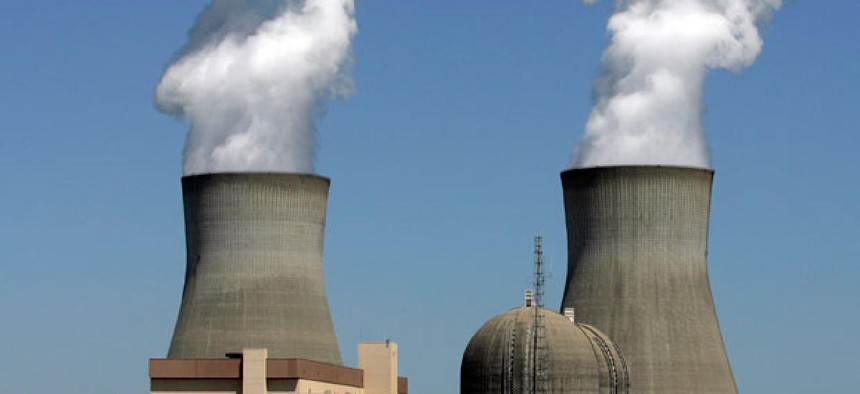
Mary Ann Chastain/AP
Lab directors urged plutonium facility delay, former Biden aide charges
The proposal to delay building the facility has since drawn Republican fire.
WASHINGTON -- A former White House aide on Monday said the directors of the U.S. national laboratories “came forward” during closed-door budget-planning sessions five months ago to propose a delay in building a plutonium research facility, a plan that has since drawn Republican fire (see GSN, May 29).
Lawmakers have taken great interest in what heads of the three main laboratories -- Lawrence Livermore, Los Alamos and Sandia -- think about the ramifications of delaying work on the $6 billion Chemistry and Metallurgy Research Replacement plant because these institutions play a key role in overseeing the nuclear arsenal.
The so-called CMRR building -- slated for location at Los Alamos, N.M. -- would replace a Cold War-era site that performs analytical chemistry and related research on plutonium cores, or explosive “pits,” for U.S. nuclear arms. The facility would help ensure that new and existing nuclear-weapon pits would function, if needed, despite a decades-long moratorium on underground explosive testing.
As the Obama administration was putting the final touches on its request for fiscal 2013 funds for the nuclear weapons complex, top officials fretted over the roughly $800 million in funding cuts already taken from the National Nuclear Security Administration’s 2012 budget, says Jon Wolfsthal. Until March, he was special adviser to Vice President Joseph Biden for nuclear security and nonproliferation and served on the National Security Council staff.
The nuclear agency, a semiautonomous arm of the Energy Department, oversees the national laboratories and the rest of the atomic complex. Half of the $800 million reduction for the current budget year comprised cuts to the agency’s nuclear weapons activities.
“It was the lab directors that came forward and said, ‘Because we’re concerned about the ability to fund this program and have it deliver on time, we’ve looked at it and think that there’s a way you can do the necessary sampling of plutonium work to allow us to have a certain pit production rates in the midterm, without having to build CMRR,’” said Wolfsthal, paraphrasing his understanding of the complex leaders’ recommendation.
The Obama administration went on to announce during the February release of its fiscal 2013 budget request that it planned to save $1.8 billion over the next five years via a half-decade postponement in work on the CMRR facility. Many observers interpreted the move as, in fact, spelling doom for ever building the plant (see GSN, Feb. 14). Construction of the site was to have been completed by 2024, but is now delayed indefinitely.
“Like so many DOE endeavors, we started off to 'save' a little money -- now an insignificant amount -- and the original goals got lost in the staggering spending that followed," said Roger Logan, a former head of Directed Stockpile Work at California's Livermore lab, referring to initial plans for streamlining plutonium research and pit production.
The National Nuclear Security Administration said in February that it would weigh alternative methods for meeting warhead requirements in coming years.
At the same time, the administration was reviewing whether it would still need a long-anticipated production capacity of 50 to 80 atomic pits per year -- samples of which would have to pass through the CMRR facility for analysis -- or if instead future reductions in the size of the nuclear arsenal might lessen the demand for facilities on the scale of that planned for the new research site. Currently, Los Alamos produces less than 10 pits annually, according to lab spokesman Kevin Roark.
Today’s U.S. nuclear stockpile, including both fielded and nondeployed weapons, numbers roughly 5,000 warheads. However, additional negotiated U.S.-Russian arms control reductions or Washington’s unilateral weapon retirements could lower that figure significantly in future years.
“NNSA has determined, in consultation with the national laboratories, that the existing infrastructure in the nuclear complex has the inherent capacity to provide adequate support for these missions,” according to a nuclear agency budget document released in February. As a workaround, “NNSA will modify existing facilities, and relocate some nuclear materials,” the agency said.
However, the idea that the laboratory directors were onboard with the decision to delay the CMRR project was quickly thrown into question. In a development first reported that month by the trade news publication Weapons Complex Morning Briefing, Charles McMillan, who heads Los Alamos, circulated a letter emphasizing the importance of the site to keeping the nation’s nuclear weapons in working order.
“Without CMRR, there is no identified path to meet the nation’s requirement of 50 to 80 pits per year,” McMillan told his lab staff in a Feb. 14 letter obtained by Global Security Newswire. “Assuming further investments in [Los Alamos] facilities, we are confident we can deliver -- but only a portion of that requirement.”
He elaborated in April 18 written testimony to the Senate Armed Services Strategic Forces Subcommittee.
The CMRR plant “fulfills a critical mission in supporting the analytical chemistry and metallurgy needed to certify that the plutonium used in the stockpile meets basic material requirements,” McMillan stated. He said a 60-day analysis would address potential alternatives for the new building, combined with additional measures such as recycling old pits, but emphasized that no adequate substitute had yet been identified to replace CMRR construction.
Wolfsthal this week suggested that the architects of the plan to put work on the facility on ice were none other than McMillan and his Livermore and Sandia counterparts.
“This was the lab directors coming to NNSA and saying, ‘We think we can save you money’ -- perhaps an unprecedented step – and saying, ‘We think we can do plutonium work without building the CMRR in New Mexico,’” Wolfsthal said at an Arms Control Association panel discussion in Washington.
“What the lab directors are worried about -- rightly -- is that we’re going to build facilities and not be able to fund the people that do the real work in those facilities,” he said. “So they came to us with an alternative plan.”
Wolfsthal, now deputy director of the Monterey Institute’s James Martin Center for Nonproliferation Studies, added in a subsequent interview: “What the lab directors are worried about is we’re going to build a temple to plutonium processing and we’re not going to have anybody who’s able to worship in it.”
The 2011 Budget Control Act mandates a roughly $450 billion cut in defense spending over the next decade, some of which could affect Energy Department nuclear-weapons spending. Under a sequester process, the reductions figure might more than double, unless Congress by year’s end reverses the legislation’s demand for $1.2 trillion in additional government-wide reductions.
By Wolfsthal’s account, the administration largely signed off on what McMillan and the others had proposed for the plutonium research facility. His view was first reported last month by Nuclear Weapons & Materials Monitor.
“It was the lab directors’ recommendation that was then put forward by NNSA and approved by [the White House budget office] and the Nuclear Weapons Council,” a senior oversight panel led by the Defense and Energy departments, Wolfsthal explained in the telephone interview with GSN on Monday.
“The budget requests, from their perspective -- at least as far as I understand it -- are not the problem,” he said. “The problem is the appropriations process. And what they’re worried about is that Congress won’t meet the president’s budget, and therefore they’re trying to make sure there’s some margin for error in the system.”
Representative Michael Turner (R-Ohio), who chairs the House Armed Services Strategic Forces Subcommittee, has led criticism within the chamber of President Obama’s nuclear modernization plans in general and, in this case, has charged that the president “failed to deliver” the promised CMRR facility.
“All of a sudden, Congress is screaming, ‘You broke your promise. I think it’s just partisan gamesmanship,” Wolfsthal said at the Monday event. “I think it’s largely designed to try and detract from the president’s pretty impressive accomplishment in investing in the nuclear complex in a reasonable way.”
Others say, though, that it would be wrong to conclude that McMillan or other laboratory directors initiated work on the proposal for a five-year CMRR delay.
“When we are asked to provide technical alternatives, we do,” McMillan said in a Monday written response to questions following Wolfsthal’s remarks. “We are committed to delivering the best scientific and technical solutions to ensure the safety, security and effectiveness of the nation’s nuclear deterrent.”
He called the decision to defer work on the CMRR building “a painful one for Los Alamos.”
“I continue to maintain that the capabilities of the proposed CMRR facility are vital to national security,” McMillan asserted in the statement provided to GSN.
The internal administration budget deliberations in late December and early January were more of a back-and-forth between NNSA officials and the research sites, according to some. All sides reportedly voiced concerns about how best to fulfill responsibilities for maintaining and safeguarding the nuclear stockpile under growing fiscal constraints.
Josh McConaha, an NNSA spokesman, was among those this week describing the initiative to delay the plutonium facility as evolving out of interagency discussions.
“The decision to defer [CMRR] by at least five years was made by [NNSA] Administrator Tom D'Agostino, Principal Deputy Administrator Neile Miller, and Deputy Administrator for Defense Programs Don Cook.,” McConaha said in a written response to questions. “It came after significant consultation with the directors of Los Alamos, Lawrence Livermore, and Sandia national laboratories.”
The Budget Control Act forced administration officials “to put our heads together and come up with an alternative that guaranteed the deterrent would remain safe, secure and effective,” the nuclear agency spokesman said. “Our alternate plan is a true team effort, and included the administrator, the lab directors, and staff from across the country.”
Wolfsthal described a more proactive role for the laboratory directors, but also acknowledged a give-and-take quality to the decision-making.
“My understanding is that this was direct communications, if not face-to-face meetings, within the normal budget-planning process, which is Department of Energy, NNSA and the lab directors,” he told GSN. “Nobody takes this as dramatic television drama.”
Spokesmen for the Livermore and Sandia laboratories declined response to questions about the matter.







